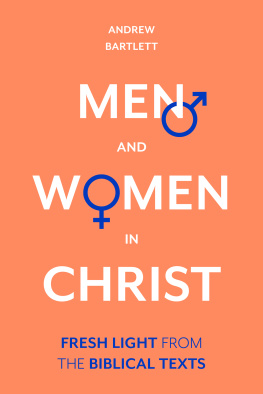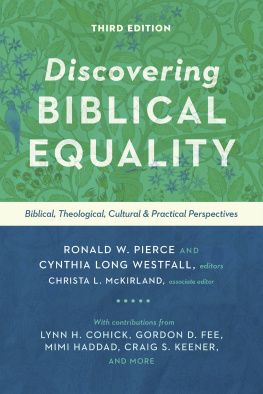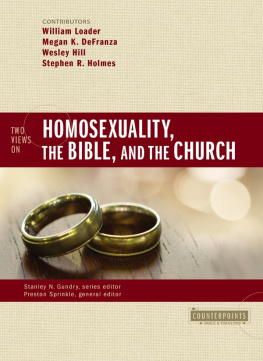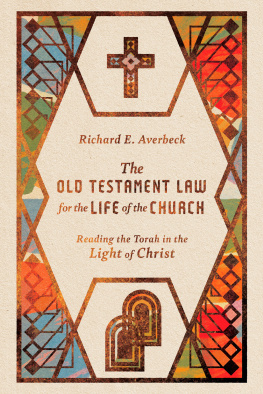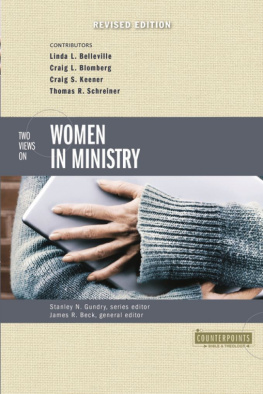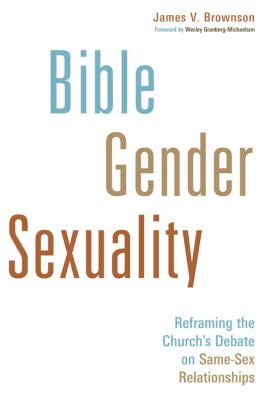BDAG A GreekEnglish Lexicon of the New Testament and Other Early Christian Literature , ed. W. Bauer, F. W. Danker, W. F. Arndt and F. W. Gingrich, 3rd ed. (Chicago: University of Chicago Press, 2000)
BNTC Blacks New Testament Commentaries
BST The Bible Speaks Today
BT The Bible Translator
CBE Christians for Biblical Equality
CBMW Council on Biblical Manhood and Womanhood
DBE Ronald W. Pierce and Rebecca Merrill Groothuis (eds.), Discovering Biblical Equality: Complementarity without Hierarchy , 2nd ed. (Downers Grove, IL: InterVarsity Press, 2005)
EFBT Wayne Grudem, Evangelical Feminism and Biblical Truth: An Analysis of 118 Disputed Questions (Leicester: Inter-Varsity Press, 2004)
EvQ Evangelical Quarterly
FIEC Fellowship of Independent Evangelical Churches
JBMW Journal for Biblical Manhood and Womanhood
JETS Journal of the Evangelical Theological Society
JGRChJ Journal of Greco-Roman Christianity and Judaism
JSNT Journal for the Study of the New Testament
LSJ A GreekEnglish Lexicon , ed. Henry George Liddell, Robert Scott and Henry Stuart Jones, 9th ed., with rev. supplement by P. G. W. Glare (Oxford: Oxford University Press, 1996), electronic edition under CC-BY-SA by the Perseus Project of Tufts University
M&W Philip B. Payne, Man and Woman, One in Christ: An Exegetical and Theological Study of Pauls Letters (Grand Rapids: Zondervan, 2009)
NCBC New Century Bible Commentary
NICNT New International Commentary on the New Testament
NIGTC New International Greek Testament Commentary
NTS New Testament Studies
PNTC Pillar New Testament Commentary
RBMW John Piper and Wayne Grudem (eds.), Recovering Biblical Manhood and Womanhood: A Response to Evangelical Feminism (Wheaton: Crossway, 1991)
TGC The Gospel Coalition
ThZ Theologische Zeitschrift
TNTC Tyndale New Testament Commentary
TrinJ Trinity Journal
TynBul Tyndale Bulletin
UBS The New GreekEnglish Interlinear New Testament: A New Interlinear Translation of the Greek New Testament , trans. Robert K. Brown and Philip W. Comfort, United Bible Societies 4th, corrected ed. with the New Revised Standard Version (Carol Stream, IL: Tyndale House, 1990)
WBC Word Biblical Commentary
WITC Andreas J. Kstenberger and Thomas R. Schreiner (eds.), Women in the Church: An Interpretation and Application of 1 Timothy 2:915 , 3rd ed. (Wheaton: Crossway, 2016)
Bible versions
amp Amplified Bible, 2015
asv American Standard Version
brg BRG Bible, 2012
ceb Common English Bible, 2011
cev Contemporary English Version, 1995
cjb Complete Jewish Bible, 1998
darby Darby Translation
dlnt Disciples Literal New Testament, 2011
dra Douay-Rheims 1899 American Edition
ehv Evangelical Heritage Version, New Testament & Psalms, 2017
esv English Standard Version (Anglicized), 2001
gnt Good News Translation, 1992
gnv Geneva Bible, 1599
gw Gods Word Translation, 1995
isv International Standard Version, 19952014
kjv King James Version
mounce Mounce Reverse-Interlinear New Testament, 2011
nabre New American Bible (Revised Edition), 2010
nasb New American Standard Bible, 1995
net New English Translation, 19962006
niv New International Version (Anglicized), 2011
niv 1984 New International Version, 1984
nkjv New King James Version, 1982
nlv New Life Version, 1969
nmb New Matthew Bible, 2016
nog Names of God Bible, 2011
nrsv New Revised Standard Version, 1989
nte New Testament for Everyone, 2011
ojb Orthodox Jewish Bible, 2011
phillips J. B. Phillips New Testament, 1972
rsv Revised Standard Version, 1971
rv Revised Version, 1881
tlb The Living Bible, 1971
tlv Tree of Life Version, 2015
tpt The Passion Translation, 2017
voice The Voice, 2012
we Worldwide English (New Testament), 1998
wyc Wycliffe Bible, 2001
ylt Youngs Literal Translation
In appendix 1 I suggested that cultural ideas and traditions in Bible translation have had powerful impacts upon verses bearing on a womans place, and therefore require special attention to guard against them. This is borne out by what we have seen in nearly every chapter. In particular, we have seen the influence of traditional patriarchal culture upon translation choices.
In chapter 2 we saw the obscure translation of 1 Corinthians 7:4 by the niv 1984, which hid from the reader Pauls statement about a wifes authority over her husbands body.
In chapter 4 we saw that in Ephesians 5:23 both the esv and the niv obscure Pauls designation of Christ as head in the sense of saviour. We saw that many English versions do not accurately translate the first word of Ephesians 5:24 (but), because they have not grasped Pauls train of thought, which is that he wants wives to submit to their husbands even though their husbands are not in authority over them. We also saw that in 1 Timothy 5:14 Paul wants widows to remarry and be masters over their households. esv and niv dilute this to manage and ehv to keep house.
In chapter 5 we saw that English translations of Judges 4:4 do not agree on whether Deborah was judging Israel or leading Israel, but that it is clear both from Judges 2:1619 and from the book as a whole that the Hebrew word is used to refer to governing, and not only to judging.
In chapter 6 we saw that in 1 Peter 3:7 many versions follow a translation tradition which contains a mistake. The mistake obscures Peters reasoning that husbands should behave with gentleness towards their wives as the weaker partner, and should pay honour to their wives as co-heirs of salvation.
In chapter 7 we saw many translation issues, mainly arising from a mistaken conception that in 1 Corinthians 11 Paul is writing about veils as a symbol of women being under mens authority. We saw that some versions reverse the meaning of verse 10, effectively deleting Pauls words that a woman ought to have authority over her head and replacing them with a creative paraphrase to the effect that a woman ought to have her head covered as a symbol of her subjection to mens authority. We saw translators reversing the meaning of verse 16, changing no such custom to no other custom. We saw that in some instances in this passage the esv translates anr as husband and gun as wife, despite the absence of verbal signals flagging these specific meanings in place of the more general meanings of man and woman.
In chapter 9 we saw that 1 Corinthians 14:33 should not be split into two and partly joined onto verses 3435 as in some versions. In chapter 10 we saw that, at the least, our Bibles should have a footnote, along the lines of: Manuscript evidence indicates that verses 34 and 35 may be an interpolation, not original to Paul, and should be omitted. Better, verses 3435 should themselves be placed in italics or in a footnote, together with an explanation that discrepancies in manuscripts suggest that they are of doubtful authenticity.
In chapter 11 we saw that translations of 1 Timothy 1:3 which refer to false doctrine produce an unduly abstract impression of what Paul is concerned about, which extends to behaviour.
In chapter 12 we saw that 1 Timothy 2:12 should not be divided off from verse 11. It should not be translated as many versions have it, along the lines: I do not permit a woman to teach or to exercise authority over a man; she is to keep silent. From the context, a literal rendering would be on the lines of: I am not permitting a woman to teach and overpower a man, but to be in quietness. Moreover, the conventional picture of gossipy women poking their noses into other peoples business, as depicted in most English translations of 1 Timothy 5:13, misses the mark. The wealthy young widows are going around from house to house talking nonsense (not gossip) and dabbling in sorcery (not being busybodies). They are abandoning their faith (1 Tim. 5:12, esv ), not breaking their first pledge ( niv ). In Pauls subsequent letter the women who are under the sway of false teachers (2 Tim. 3:6) are not silly (as in asv and eighteen other versions) or weak-willed (as in cjb and ojb ). These descriptions reflect the traditional cultural view that women are inherently defective in nature. The Greek text contains no word meaning silly or weak-willed. Pauls attitude to these women is not contempt but concern. They are little women, that is, they are immature, and hence vulnerable to false teachers.

